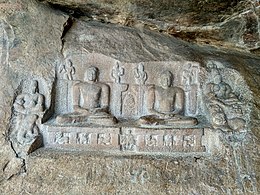Vallimalai Jain caves
Vallimalai Jain caves are located in Vallimalai village in Katpadi taluk of Vellore district, Tamil Nadu.
| Vallimalai Jain Beds | |
|---|---|
 Vallimalai Jain caves | |
| Religion | |
| Affiliation | Jainism |
| Location | |
| Location | Vallimalai, Vellore, Tamil Nadu |
| Geographic coordinates | 13°04′24.6″N 79°15′50.9″E |
| Architecture | |
| Style | Dravidian architecture |
| Creator | Rachamalla II |
| Date established | 2nd century BCE |
| Completed | 870 CE |
| Materials | Rock cut |
History
Vallimalai Jain caves contains natural caverns that were inhabitted by Digambar monks in early historic period.[1][2] The monks from Bihar used to come here during the late-maurya period. The smooth and polished beds were carved during the rule of Satavahana dynasty.[3] A total of five inscription are found[4] with one of the inscriptions dating back to 8th century.[5] The Jain carvings were created during the reign of Ganga King Rachamalla II in c. 870 CE after conquest of this region from Chola kings.[6][7][8] Vallaimalai was an important Jain center during 8th-9th century.[7]
Architecture
Vallimalai is an important Jain site with several carvings of sculptures of tirthankara. The caverns is 40 by 20 feet (12.2 m × 6.1 m) with height varying between 7–10 feet (2.1–3.0 m). There is also a temple in the region which was converted to a Hindu temple.[9] The caves consist of three chambers, two of the these chambers contain images of Jain tirthankar. Above this group there are the remains of a wall, believed to have been a small fort occupied by Jains.[10] A torana is found above Jain images similar to carvings of Badami cave temples.[11]
There is an image of Ambika in sukhasana position wearing a necklace, armbands and crown.[12] Ambika is depicted sitting on a lion with carvings of her two sons below her pedestal.[13] There is also image of Padmavati with 4 hands, holding goad and noose in upper right and left hands.[7]
Conservation
These caves are protected by Archaeological Survey of India.[14] In 2014, "Ahima Walks" was organised in the region to promote the place.[8]
See also
| Wikimedia Commons has media related to Vallimalai Jain caves. |
Reference
Citations
- Ramaswamy 2017, p. 384.
- The Hindu, 2018 & Vallimalai.
- Ramaswamy 2017, p. 52.
- Umamaheshwari 2018, p. 38.
- Subramanian 2002, p. 36.
- Aravamuthan 1992, p. 30.
- Chennai museum & Vallimalai, p. 59.
- The New Indian Express, 2014 & Vallimalai.
- Chennai museum & Vallimalai, p. 138.
- Sewell 1882, p. 156.
- Owen 2012, p. 60.
- The Hindu, 2012 & icons of grace.
- Chennai museum & Vallimalai, p. 105.
- ASI & Vellore sub-cirle.
Sources
- Subramanian, K. R. (2002), Origin of Saivism and Its History in the Tamil Land, Asian Educational Services, ISBN 9788120601444
- Ramaswamy, Vijaya (2017), Historical Dictionary of the Tamils, Historical Dictionaries of Peoples and Cultures (2 ed.), Rowman & Littlefield, ISBN 9781538106860
- Sewell, Robert (1882), Lists of the Antiquarian Remains in the Presidency of Madras, Historical Dictionaries of Peoples and Cultures, 2, E. Keys, at the Government Press
- Umamaheshwari, R. (2018), Reading History with the Tamil Jainas: A Study on Identity, Memory and Marginalisation, Sophia Studies in Cross-cultural Philosophy of Traditions and Cultures, 2, Springer, ISBN 9788132237563
- Aravamuthan, T. G. (1992), Portrait Sculpture in South India, Asian Educational Services, ISBN 9788120608009
- Owen, Lisa (2012), Carving Devotion in the Jain Caves at Ellora, Brill's Indological Library, 41, Brill Publishers, ISBN 9789004206298
- "Vellore sub-cirle". Archaeological Survey of India.
- Murthi, V Narayana (5 August 2014). "'Ahimsa Walks' to Save Jain Monuments at Vallimalai". The New Indian Express.
- "On a walk to explore lesser known heritage spots". The Hindu. 20 November 2018.
- "Icons of grace". The Hindu. 15 June 2012.
- "ICONOGRAPHY OF THE JAIN IMAGES IN THE GOVERNMENT MUSEUM". Government Museum, Chennai.